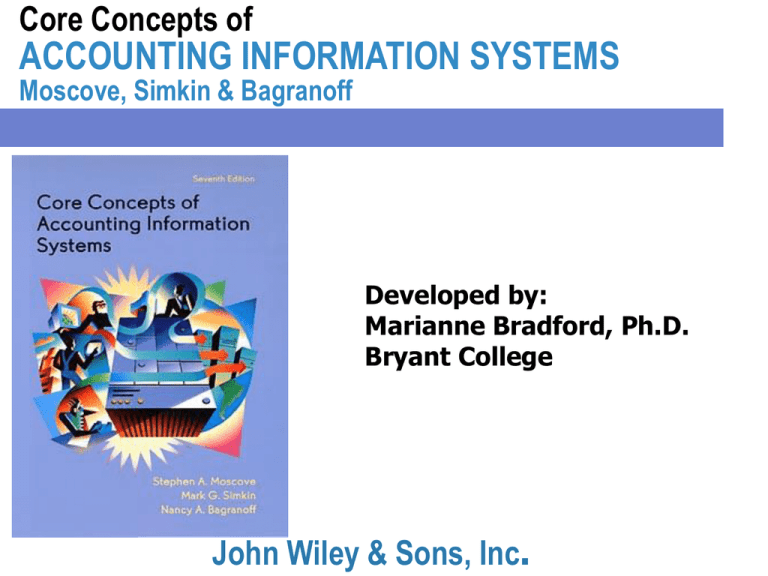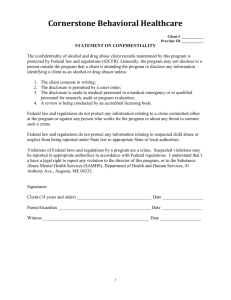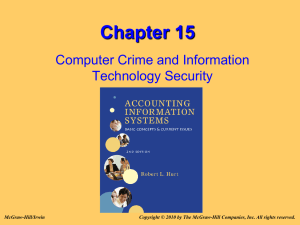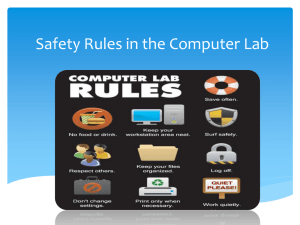
Core Concepts of
ACCOUNTING INFORMATION SYSTEMS
Moscove, Simkin & Bagranoff
Developed by:
Marianne Bradford, Ph.D.
Bryant College
John Wiley & Sons, Inc.
Chapter 9
Computer Crime and Ethics
•
•
•
•
•
Introduction
Computer Crime: An Overview
Examples of Computer Crime Cases
Thwarting Computer Abuse
Computers and Ethical Behavior
Computer Crime
• Computer crime is using the computer either
directly or indirectly in a criminal act.
• A good definition of computer crime is
important because it affects how the statistics
are accumulated.
• It is speculated that a relatively small
proportion of computer crime gets detected
and an even smaller proportion gets reported.
Legislation
• Of the federal legislation governing the use
of computers, The Computer Fraud and
Abuse Act of 1986 is perhaps the most
important.
• This Act may not be powerful enough to
prosecute computer abuses of the 21st
century such as types of Internet and
telecommunications frauds.
Computer Fraud
• Computer fraud is any illegal act for
which knowledge of computer technology
is essential for its perpetration,
investigation, or prosecution.
• Economic espionage, the theft of
information and intellectual property, is
one type of computer fraud.
The Lack of
Computer-Crime Statistics
• Good statistics on computer crime are mostly
unavailable.
• Three reasons why statistics are unavailable are :
(1) private companies handle abuse internally
(2) surveys of computer abuse are often
ambiguous
(3) most computer abuse is probably
not discovered.
The Growth of
Computer Crime
• Computer crime is growing because of
– Exponential growth in computer resources
– Internet pages give step-by-step instructions
on how to perpetrate computer crime
– Spending on computer controls has
grown at a slow rate
Four Representative
Computer Crimes Cases
• Manipulating Computer Files: The
Equity Funding Corporation of America
• Compromising Valuable Information:
The TRW Credit Data Case
• Computer Hacking: The Kevin D.
Mitnick Case
• Computer Viruses: Robert T. Morris and
the Internet Virus Case
The Equity Funding Case
• Landmark case of computer crime.
• Control procedures extremely lax company maintained an open shop.
• Analysis:
– Insurance industry learned how easily computers
can create bogus insurance policies.
– IS personnel learned importance of computer
security.
– Court litigation taught auditing profession that
ineffective audit techniques were not an adequate
legal defense against charges of negligence.
The TRW Credit Data Case
• This valuable information computer
crime is well known.
• The valuable information was
computerized credit data.
• Two key issues:
– the propriety of the input information
– the protection afforded both consumer and
user in the accuracy and use of credit
information
The Kevin D. Mitnick Case
• Hackers are people who break into the computer
files of others for fun or personal gain.
• Shoulder surfing is stealing calling credit numbers at
public phones.
• Password controls can limit computer access to bona
fide users.
• Social engineering is posing as bona fide employees.
• Lock-out systems disconnect telephone users after a
set number of unsuccessful login attempts.
• Dial-back systems first disconnect all login users, but
reconnect legitimate users after checking their
passwords against lists of bona fide user codes.
Robert T. Morris and the
Internet Virus
• Created one of the world’s most famous
compute viruses.
• Became first person to be indicted under
the Computer Fraud and Abuse Act of
1986.
• This case illustrates vulnerability of
networks to virus infections.
Computer Viruses
• A computer virus is a program that disrupts
normal data processing and that can usually
replicate itself onto other files, computer
systems or networks.
• Boot-sector viruses hide in the boot sectors of a
disk, where the operating system accesses them.
• Worm viruses replicate themselves until the
user runs out of memory or disk space.
Robert T. Morris and the
Internet Virus Case
• Trojan Horse programs reside in legitimate
copies of computer programs.
• Logic Bomb programs remain dormant until
the computer system encounters a specific
condition.
• A virus may be stored in an
applet, which is a small program
stored on a WWW server.
Methods for Thwarting Computer
Viruses: Anti-Virus Software
• Anti-virus software includes computer
programs that can:
– scan computer disks for virus-like coding;
– identify active viruses already lodged in computer
systems;
– cleanse computer systems
already infected;
– perform a combination of
these activities.
Drawbacks of Anti-Virus
Software Programs
• Anti-virus programs provide less-thancomplete protection because
– new, more powerful viruses are always being
written that can avoid known detection schemes.
– anti-virus programs can contained virus
routines.
Anti-Virus
Procedural Controls
• Buy shrink-wrapped software from
reputable sources
• Avoid illegal software copying
• Do not download suspicious Internet files
• Delete email messages from unknown
sources before opening them
• Maintain complete backup files
Organizational Safeguards
Against Computer Viruses
• Educate employees about viruses.
• Encourage employees to follow virus prevention and
detection techniques.
• Establish policies that discourage the free exchange of
computer disks or externally acquired computer
programs.
• Use computer passwords to thwart unauthorized users
from accessing the company’s operating systems and
files.
• Use anti-virus filters on LANs and WANs.
• Have an approved and tested disaster recovery plan.
Methods for
Thwarting Computer Abuse
• Enlist top management support
• Increase employee awareness and
education
• Implement controls
• Identify computer criminals
– Look at technical backgrounds,
morals, and gender and age
Methods for
Thwarting Computer Abuse
• Recognize the symptoms of employee fraud
– Accounting irregularities such as forged,
altered or destroyed input documents
– Internal control weaknesses
– Behavioral or lifestyle changes in an employee
– Unreasonable anomalies that go unchallenged
• Employ forensic
accountants
Computers and Ethical
Behavior
• Ethics is a set of moral principles or
values.
• Ethical behavior involves making choices
and judgments that are morally proper
and then acting accordingly.
• Ethics can govern and organization as
well as individuals.
Ethical Issues
•
•
•
•
•
•
Honesty
Protecting Computer Systems
Protecting Confidential Information
Social Responsibility
Rights of Privacy
Acceptable Use of Computer
Hardware and Software.
How Organizations
Encourage Ethical Behavior
• Inform employees that ethics are important.
• Formally expose employees to relevant cases that
teach how to act in specific situations.
• Teach by example, that is, by managers acting
responsibly.
• Use job promotions and other benefits to reward
those employees who act responsibly.
• Encourage employees to join professional
organizations with codes of conduct such as Codes of
Conduct and Good Practice for Certified Computer
Professional.
Copyright
Copyright 2001 John Wiley & Sons, Inc. All rights reserved.
Reproduction or translation of this work beyond that permitted in
Section 117 of the 1976 United States Copyright Act without the
express written permission of the copyright owner is unlawful.
Request for further information should be addressed to the
Permissions Department, John Wiley & Sons, Inc. The purchaser may
make backup copies for his/her own use only and not for distribution
or resale. The Publisher assumes no responsibility for errors,
omissions, or damages, caused by the use of these programs or from
the use of the information contained herein.
Chapter 9





